battery replacement Seat Exeo ST 2012 Owner's manual
[x] Cancel search | Manufacturer: SEAT, Model Year: 2012, Model line: Exeo ST, Model: Seat Exeo ST 2012Pages: 325, PDF Size: 5.56 MB
Page 6 of 325
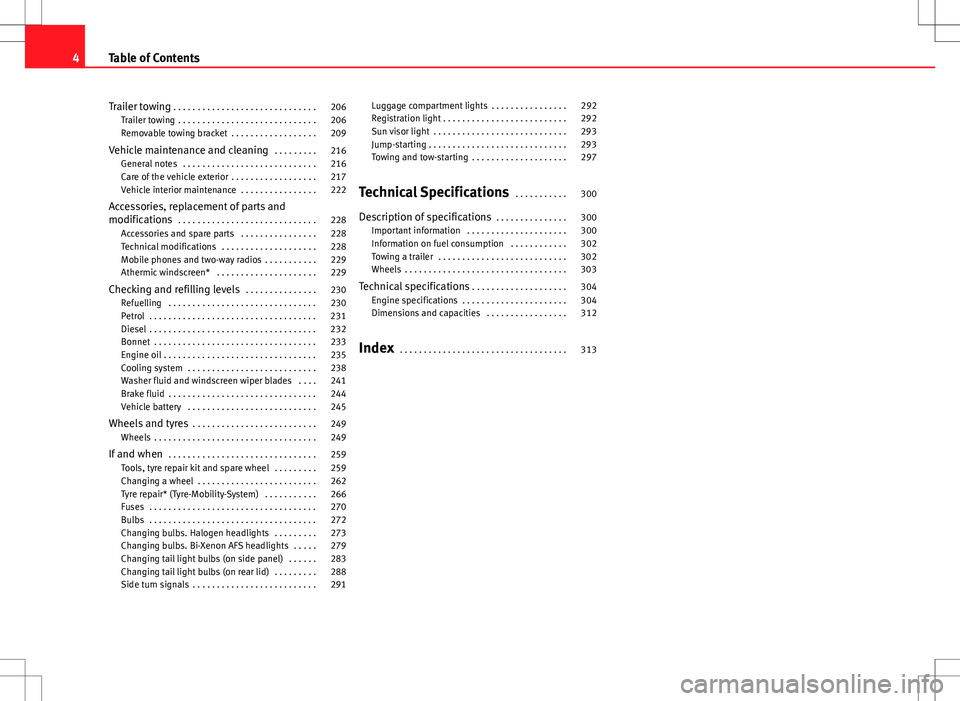
Trailer towing . . . . . . . . . . . . . . . . . . . . . . . . . . . . . . 206
Trailer towing . . . . . . . . . . . . . . . . . . . . . . . . . . . . . 206
Removable towing bracket . . . . . . . . . . . . . . . . . . 209
Vehicle maintenance and cleaning . . . . . . . . . 216
General notes . . . . . . . . . . . . . . . . . . . . . . . . . . . . 216
Care of the vehicle exterior . . . . . . . . . . . . . . . . . . 217
Vehicle interior maintenance . . . . . . . . . . . . . . . . 222
Accessories, replacement of parts and
modifications . . . . . . . . . . . . . . . . . . . . . . . . . . . . . 228
Accessories and spare parts . . . . . . . . . . . . . . . . 228
Technical modifications . . . . . . . . . . . . . . . . . . . . 228
Mobile phones and two-way radios . . . . . . . . . . . 229
Athermic windscreen* . . . . . . . . . . . . . . . . . . . . . 229
Checking and refilling levels . . . . . . . . . . . . . . . 230
Refuelling . . . . . . . . . . . . . . . . . . . . . . . . . . . . . . . 230
Petrol . . . . . . . . . . . . . . . . . . . . . . . . . . . . . . . . . . . 231
Diesel . . . . . . . . . . . . . . . . . . . . . . . . . . . . . . . . . . . 232
Bonnet . . . . . . . . . . . . . . . . . . . . . . . . . . . . . . . . . . 233
Engine oil . . . . . . . . . . . . . . . . . . . . . . . . . . . . . . . . 235
Cooling system . . . . . . . . . . . . . . . . . . . . . . . . . . . 238
Washer fluid and windscreen wiper blades . . . . 241
Brake fluid . . . . . . . . . . . . . . . . . . . . . . . . . . . . . . . 244
Vehicle battery . . . . . . . . . . . . . . . . . . . . . . . . . . . 245
Wheels and tyres . . . . . . . . . . . . . . . . . . . . . . . . . . 249
Wheels . . . . . . . . . . . . . . . . . . . . . . . . . . . . . . . . . . 249
If and when . . . . . . . . . . . . . . . . . . . . . . . . . . . . . . . 259
Tools, tyre repair kit and spare wheel . . . . . . . . . 259
Changing a wheel . . . . . . . . . . . . . . . . . . . . . . . . . 262
Tyre repair* (Tyre-Mobility-System) . . . . . . . . . . . 266
Fuses . . . . . . . . . . . . . . . . . . . . . . . . . . . . . . . . . . . 270
Bulbs . . . . . . . . . . . . . . . . . . . . . . . . . . . . . . . . . . . 272
Changing bulbs. Halogen headlights . . . . . . . . . 273
Changing bulbs. Bi-Xenon AFS headlights . . . . . 279
Changing tail light bulbs (on side panel) . . . . . . 283
Changing tail light bulbs (on rear lid) . . . . . . . . . 288
Side turn signals . . . . . . . . . . . . . . . . . . . . . . . . . . 291 Luggage compartment lights . . . . . . . . . . . . . . . . 292
Registration light . . . . . . . . . . . . . . . . . . . . . . . . . . 292
Sun visor light . . . . . . . . . . . . . . . . . . . . . . . . . . . . 293
Jump-starting . . . . . . . . . . . . . . . . . . . . . . . . . . . . . 293
Towing and tow-starting . . . . . . . . . . . . . . . . . . . . 297
Technical Specifications . . . . . . . . . . . 300
Description of specifications . . . . . . . . . . . . . . . 300
Important information . . . . . . . . . . . . . . . . . . . . . 300
Information on fuel consumption . . . . . . . . . . . . 302
Towing a trailer . . . . . . . . . . . . . . . . . . . . . . . . . . . 302
Wheels . . . . . . . . . . . . . . . . . . . . . . . . . . . . . . . . . . 303
Technical specifications . . . . . . . . . . . . . . . . . . . . 304
Engine specifications . . . . . . . . . . . . . . . . . . . . . . 304
Dimensions and capacities . . . . . . . . . . . . . . . . . 312
Index . . . . . . . . . . . . . . . . . . . . . . . . . . . . . . . . . . . 313
4Table of Contents
Page 103 of 325
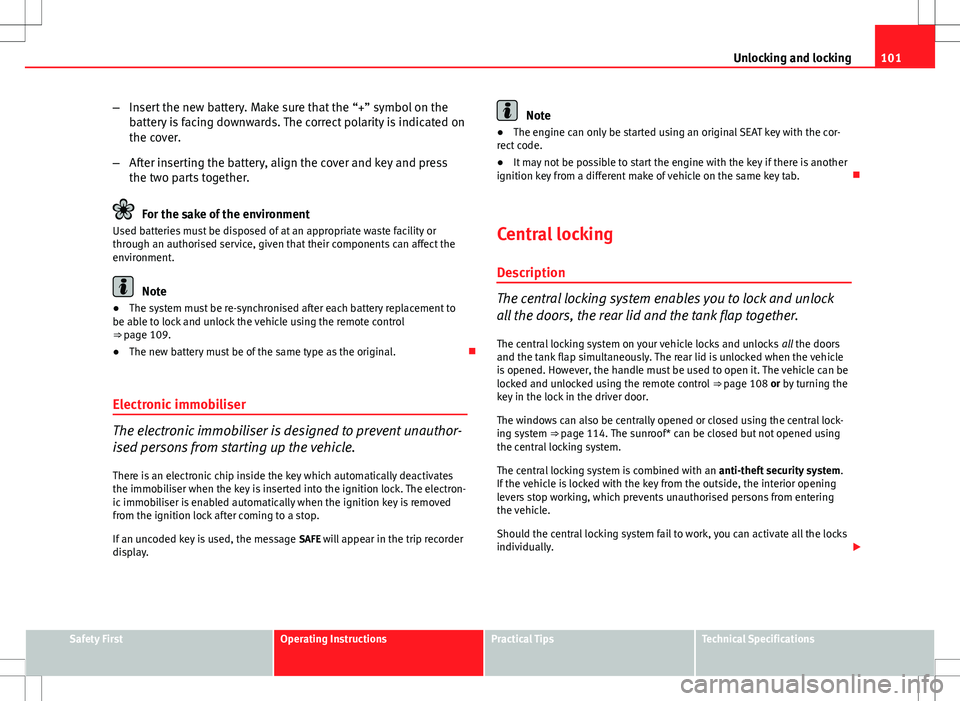
101
Unlocking and locking
– Insert the new battery. Make sure that the “+” symbol on the
battery is facing downwards. The correct polarity is indicated on
the cover.
– After inserting the battery, align the cover and key and press
the two parts together.
For the sake of the environment
Used batteries must be disposed of at an appropriate waste facility or
through an authorised service, given that their components can affect the
environment.
Note
● The system must be re-synchronised after each battery replacement to
be able to lock and unlock the vehicle using the remote control
⇒ page 109.
● The new battery must be of the same type as the original.
Electronic immobiliser
The electronic immobiliser is designed to prevent unauthor-
ised persons from starting up the vehicle.
There is an electronic chip inside the key which automatically deactivates
the immobiliser when the key is inserted into the ignition lock. The electron-
ic immobiliser is enabled automatically when the ignition key is removed
from the ignition lock after coming to a stop.
If an uncoded key is used, the message SAFE will appear in the trip recorder
display.
Note
● The engine can only be started using an original SEAT key with the cor-
rect code.
● It may not be possible to start the engine with the key if there is another
ignition key from a different make of vehicle on the same key tab.
Central locking Description
The central locking system enables you to lock and unlock
all the doors, the rear lid and the tank flap together.The central locking system on your vehicle locks and unlocks all the doors
and the tank flap simultaneously. The rear lid is unlocked when the vehicle
is opened. However, the handle must be used to open it. The vehicle can be
locked and unlocked using the remote control ⇒ page 108 or by turning the
key in the lock in the driver door.
The windows can also be centrally opened or closed using the central lock-
ing system ⇒ page 114. The sunroof* can be closed but not opened using
the central locking system.
The central locking system is combined with an anti-theft security system.
If the vehicle is locked with the key from the outside, the interior opening
levers stop working, which prevents unauthorised persons from entering
the vehicle.
Should the central locking system fail to work, you can activate all the locks
individually.
Safety FirstOperating InstructionsPractical TipsTechnical Specifications
Page 110 of 325
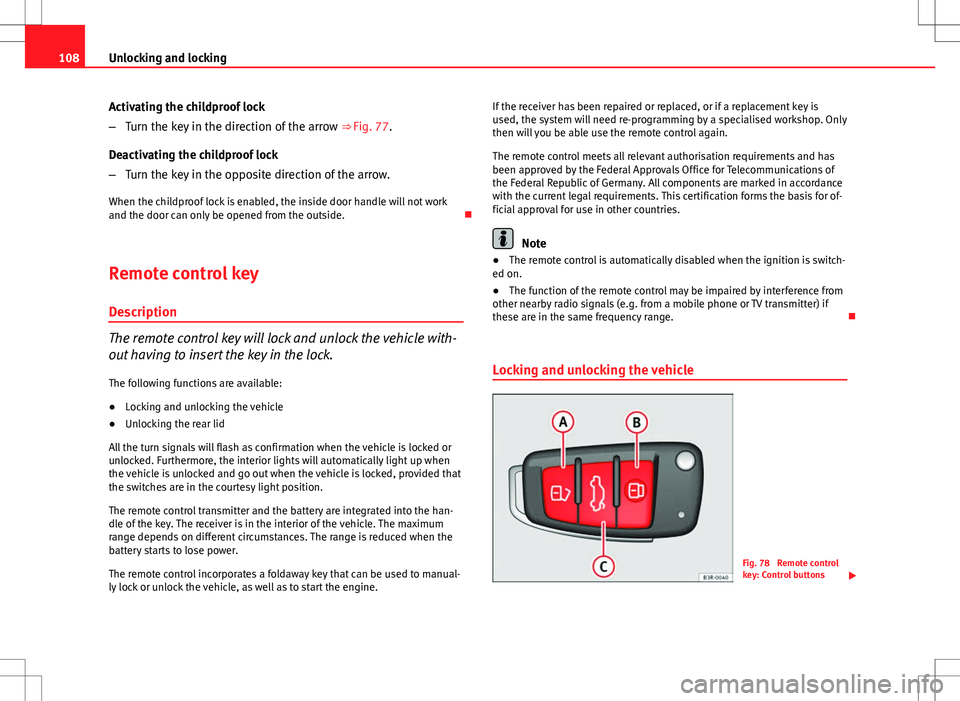
108Unlocking and locking
Activating the childproof lock
–Turn the key in the direction of the arrow ⇒ Fig. 77.
Deactivating the childproof lock
– Turn the key in the opposite direction of the arrow.
When the childproof lock is enabled, the inside door handle will not work
and the door can only be opened from the outside.
Remote control key Description
The remote control key will lock and unlock the vehicle with-
out having to insert the key in the lock. The following functions are available:
● Locking and unlocking the vehicle
● Unlocking the rear lid
All the turn signals will flash as confirmation when the vehicle is locked or
unlocked. Furthermore, the interior lights will automatically light up when
the vehicle is unlocked and go out when the vehicle is locked, provided that
the switches are in the courtesy light position.
The remote control transmitter and the battery are integrated into the han-
dle of the key. The receiver is in the interior of the vehicle. The maximum
range depends on different circumstances. The range is reduced when the
battery starts to lose power.
The remote control incorporates a foldaway key that can be used to manual-
ly lock or unlock the vehicle, as well as to start the engine. If the receiver has been repaired or replaced, or if a replacement key is
used, the system will need re-programming by a specialised workshop. Only
then will you be able use the remote control again.
The remote control meets all relevant authorisation requirements and has
been approved by the Federal Approvals Office for Telecommunications of
the Federal Republic of Germany. All components are marked in accordance
with the current legal requirements. This certification forms the basis for of-
ficial approval for use in other countries.
Note
● The remote control is automatically disabled when the ignition is switch-
ed on.
● The function of the remote control may be impaired by interference from
other nearby radio signals (e.g. from a mobile phone or TV transmitter) if
these are in the same frequency range.
Locking and unlocking the vehicle
Fig. 78 Remote control
key: Control buttons
Page 237 of 325
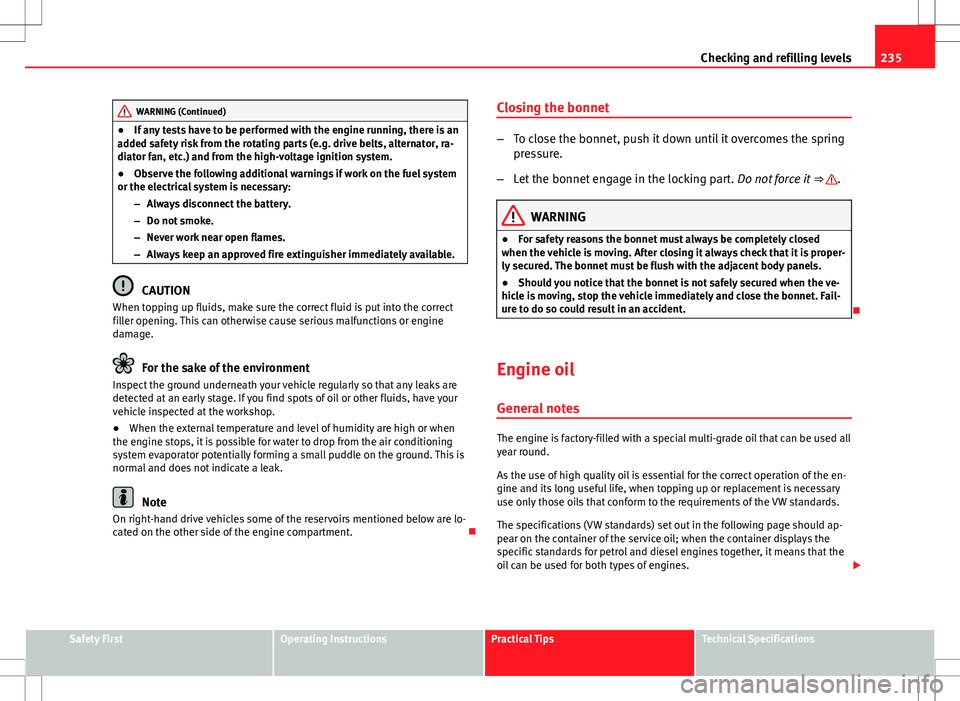
235
Checking and refilling levels
WARNING (Continued)
● If any tests have to be performed with the engine running, there is an
added safety risk from the rotating parts (e.g. drive belts, alternator, ra-
diator fan, etc.) and from the high-voltage ignition system.
● Observe the following additional warnings if work on the fuel system
or the electrical system is necessary:
–Always disconnect the battery.
– Do not smoke.
– Never work near open flames.
– Always keep an approved fire extinguisher immediately available.
CAUTION
When topping up fluids, make sure the correct fluid is put into the correct
filler opening. This can otherwise cause serious malfunctions or engine
damage.
For the sake of the environment
Inspect the ground underneath your vehicle regularly so that any leaks are
detected at an early stage. If you find spots of oil or other fluids, have your
vehicle inspected at the workshop.
● When the external temperature and level of humidity are high or when
the engine stops, it is possible for water to drop from the air conditioning
system evaporator potentially forming a small puddle on the ground. This is
normal and does not indicate a leak.
Note
On right-hand drive vehicles some of the reservoirs mentioned below are lo-
cated on the other side of the engine compartment. Closing the bonnet
–
To close the bonnet, push it down until it overcomes the spring
pressure.
– Let the bonnet engage in the locking part. Do not force it ⇒
.
WARNING
● For safety reasons the bonnet must always be completely closed
when the vehicle is moving. After closing it always check that it is proper-
ly secured. The bonnet must be flush with the adjacent body panels.
● Should you notice that the bonnet is not safely secured when the ve-
hicle is moving, stop the vehicle immediately and close the bonnet. Fail-
ure to do so could result in an accident.
Engine oil General notes
The engine is factory-filled with a special multi-grade oil that can be used all
year round.
As the use of high quality oil is essential for the correct operation of the en-
gine and its long useful life, when topping up or replacement is necessary
use only those oils that conform to the requirements of the VW standards.
The specifications (VW standards) set out in the following page should ap-
pear on the container of the service oil; when the container displays the
specific standards for petrol and diesel engines together, it means that the
oil can be used for both types of engines.
Safety FirstOperating InstructionsPractical TipsTechnical Specifications
Page 248 of 325
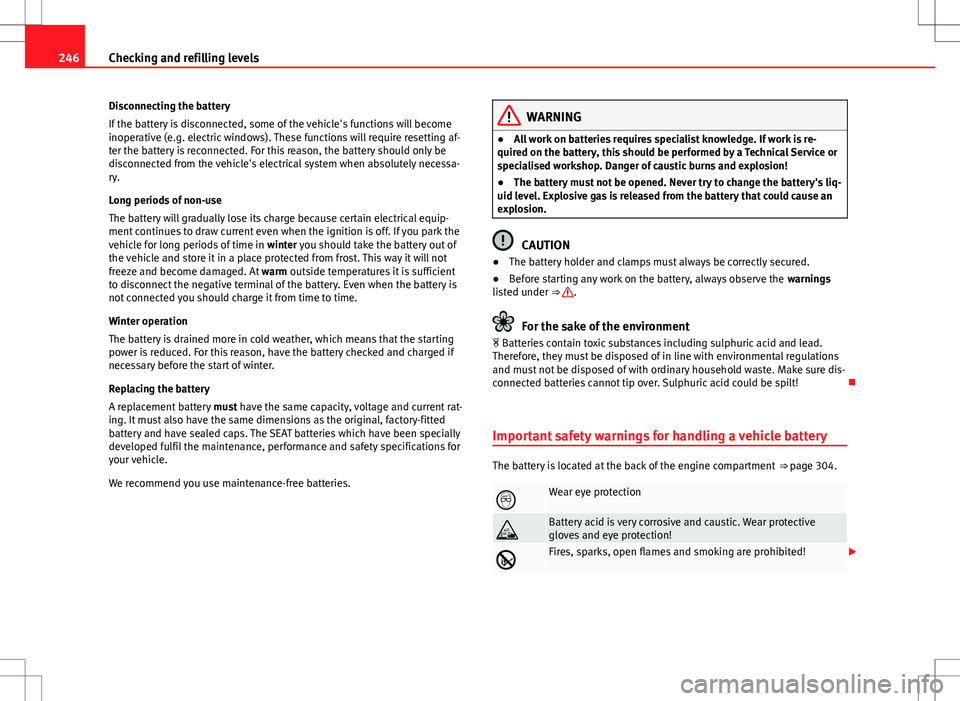
246Checking and refilling levels
Disconnecting the battery
If the battery is disconnected, some of the vehicle's functions will become
inoperative (e.g. electric windows). These functions will require resetting af-
ter the battery is reconnected. For this reason, the battery should only be
disconnected from the vehicle's electrical system when absolutely necessa-
ry.
Long periods of non-use
The battery will gradually lose its charge because certain electrical equip-
ment continues to draw current even when the ignition is off. If you park the
vehicle for long periods of time in winter you should take the battery out of
the vehicle and store it in a place protected from frost. This way it will not
freeze and become damaged. At warm outside temperatures it is sufficient
to disconnect the negative terminal of the battery. Even when the battery is
not connected you should charge it from time to time.
Winter operation
The battery is drained more in cold weather, which means that the starting
power is reduced. For this reason, have the battery checked and charged if
necessary before the start of winter.
Replacing the battery
A replacement battery must have the same capacity, voltage and current rat-
ing. It must also have the same dimensions as the original, factory-fitted
battery and have sealed caps. The SEAT batteries which have been specially
developed fulfil the maintenance, performance and safety specifications for
your vehicle.
We recommend you use maintenance-free batteries.
WARNING
● All work on batteries requires specialist knowledge. If work is re-
quired on the battery, this should be performed by a Technical Service or
specialised workshop. Danger of caustic burns and explosion!
● The battery must not be opened. Never try to change the battery's liq-
uid level. Explosive gas is released from the battery that could cause an
explosion.
CAUTION
● The battery holder and clamps must always be correctly secured.
● Before starting any work on the battery, always observe the warnings
listed under ⇒
.
For the sake of the environment
Batteries contain toxic substances including sulphuric acid and lead.
Therefore, they must be disposed of in line with environmental regulations
and must not be disposed of with ordinary household waste. Make sure dis-
connected batteries cannot tip over. Sulphuric acid could be spilt!
Important safety warnings for handling a vehicle battery
The battery is located at the back of the engine compartment ⇒ page 304.
Wear eye protection
Battery acid is very corrosive and caustic. Wear protective
gloves and eye protection!
Fires, sparks, open flames and smoking are prohibited!
Page 321 of 325
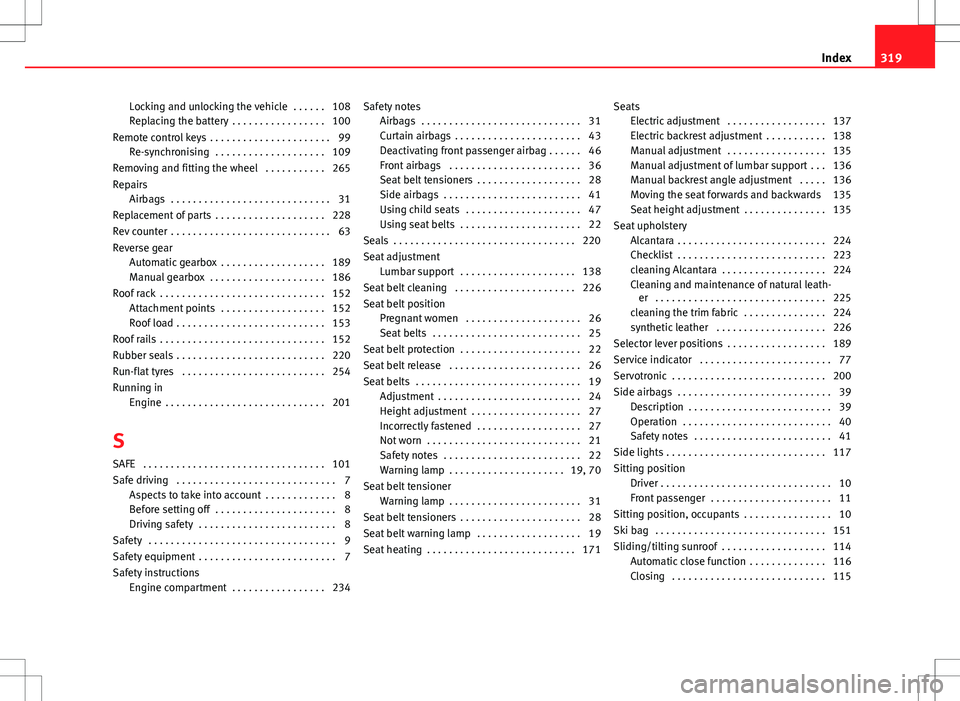
Locking and unlocking the vehicle . . . . . . 108
Replacing the battery . . . . . . . . . . . . . . . . . 100
Remote control keys . . . . . . . . . . . . . . . . . . . . . . 99 Re-synchronising . . . . . . . . . . . . . . . . . . . . 109
Removing and fitting the wheel . . . . . . . . . . . 265
Repairs Airbags . . . . . . . . . . . . . . . . . . . . . . . . . . . . . 31
Replacement of parts . . . . . . . . . . . . . . . . . . . . 228
Rev counter . . . . . . . . . . . . . . . . . . . . . . . . . . . . . 63
Reverse gear Automatic gearbox . . . . . . . . . . . . . . . . . . . 189
Manual gearbox . . . . . . . . . . . . . . . . . . . . . 186
Roof rack . . . . . . . . . . . . . . . . . . . . . . . . . . . . . . 152 Attachment points . . . . . . . . . . . . . . . . . . . 152
Roof load . . . . . . . . . . . . . . . . . . . . . . . . . . . 153
Roof rails . . . . . . . . . . . . . . . . . . . . . . . . . . . . . . 152
Rubber seals . . . . . . . . . . . . . . . . . . . . . . . . . . . 220
Run-flat tyres . . . . . . . . . . . . . . . . . . . . . . . . . . 254
Running in Engine . . . . . . . . . . . . . . . . . . . . . . . . . . . . . 201
S SAFE . . . . . . . . . . . . . . . . . . . . . . . . . . . . . . . . . 101
Safe driving . . . . . . . . . . . . . . . . . . . . . . . . . . . . . 7 Aspects to take into account . . . . . . . . . . . . . 8
Before setting off . . . . . . . . . . . . . . . . . . . . . . 8
Driving safety . . . . . . . . . . . . . . . . . . . . . . . . . 8
Safety . . . . . . . . . . . . . . . . . . . . . . . . . . . . . . . . . . 9
Safety equipment . . . . . . . . . . . . . . . . . . . . . . . . . 7
Safety instructions Engine compartment . . . . . . . . . . . . . . . . . 234 Safety notes
Airbags . . . . . . . . . . . . . . . . . . . . . . . . . . . . . 31
Curtain airbags . . . . . . . . . . . . . . . . . . . . . . . 43
Deactivating front passenger airbag . . . . . . 46
Front airbags . . . . . . . . . . . . . . . . . . . . . . . . 36
Seat belt tensioners . . . . . . . . . . . . . . . . . . . 28
Side airbags . . . . . . . . . . . . . . . . . . . . . . . . . 41
Using child seats . . . . . . . . . . . . . . . . . . . . . 47
Using seat belts . . . . . . . . . . . . . . . . . . . . . . 22
Seals . . . . . . . . . . . . . . . . . . . . . . . . . . . . . . . . . 220
Seat adjustment Lumbar support . . . . . . . . . . . . . . . . . . . . . 138
Seat belt cleaning . . . . . . . . . . . . . . . . . . . . . . 226
Seat belt position Pregnant women . . . . . . . . . . . . . . . . . . . . . 26
Seat belts . . . . . . . . . . . . . . . . . . . . . . . . . . . 25
Seat belt protection . . . . . . . . . . . . . . . . . . . . . . 22
Seat belt release . . . . . . . . . . . . . . . . . . . . . . . . 26
Seat belts . . . . . . . . . . . . . . . . . . . . . . . . . . . . . . 19 Adjustment . . . . . . . . . . . . . . . . . . . . . . . . . . 24
Height adjustment . . . . . . . . . . . . . . . . . . . . 27
Incorrectly fastened . . . . . . . . . . . . . . . . . . . 27
Not worn . . . . . . . . . . . . . . . . . . . . . . . . . . . . 21
Safety notes . . . . . . . . . . . . . . . . . . . . . . . . . 22
Warning lamp . . . . . . . . . . . . . . . . . . . . . 19, 70
Seat belt tensioner Warning lamp . . . . . . . . . . . . . . . . . . . . . . . . 31
Seat belt tensioners . . . . . . . . . . . . . . . . . . . . . . 28
Seat belt warning lamp . . . . . . . . . . . . . . . . . . . 19
Seat heating . . . . . . . . . . . . . . . . . . . . . . . . . . . 171 Seats
Electric adjustment . . . . . . . . . . . . . . . . . . 137
Electric backrest adjustment . . . . . . . . . . . 138
Manual adjustment . . . . . . . . . . . . . . . . . . 135
Manual adjustment of lumbar support . . . 136
Manual backrest angle adjustment . . . . . 136
Moving the seat forwards and backwards 135
Seat height adjustment . . . . . . . . . . . . . . . 135
Seat upholstery Alcantara . . . . . . . . . . . . . . . . . . . . . . . . . . . 224
Checklist . . . . . . . . . . . . . . . . . . . . . . . . . . . 223
cleaning Alcantara . . . . . . . . . . . . . . . . . . . 224
Cleaning and maintenance of natural leath-er . . . . . . . . . . . . . . . . . . . . . . . . . . . . . . . 225
cleaning the trim fabric . . . . . . . . . . . . . . . 224
synthetic leather . . . . . . . . . . . . . . . . . . . . 226
Selector lever positions . . . . . . . . . . . . . . . . . . 189
Service indicator . . . . . . . . . . . . . . . . . . . . . . . . 77
Servotronic . . . . . . . . . . . . . . . . . . . . . . . . . . . . 200
Side airbags . . . . . . . . . . . . . . . . . . . . . . . . . . . . 39 Description . . . . . . . . . . . . . . . . . . . . . . . . . . 39
Operation . . . . . . . . . . . . . . . . . . . . . . . . . . . 40
Safety notes . . . . . . . . . . . . . . . . . . . . . . . . . 41
Side lights . . . . . . . . . . . . . . . . . . . . . . . . . . . . . 117
Sitting position Driver . . . . . . . . . . . . . . . . . . . . . . . . . . . . . . . 10
Front passenger . . . . . . . . . . . . . . . . . . . . . . 11
Sitting position, occupants . . . . . . . . . . . . . . . . 10
Ski bag . . . . . . . . . . . . . . . . . . . . . . . . . . . . . . . 151
Sliding/tilting sunroof . . . . . . . . . . . . . . . . . . . 114 Automatic close function . . . . . . . . . . . . . . 116
Closing . . . . . . . . . . . . . . . . . . . . . . . . . . . . 115
319
Index